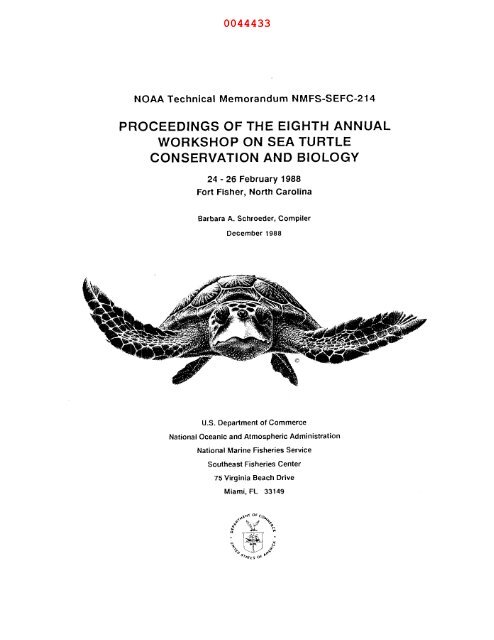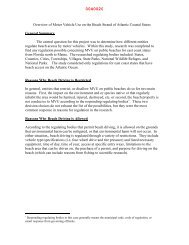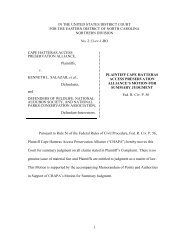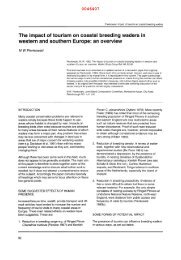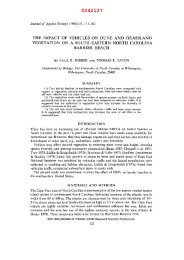Sea Turtle Biology & Conservation Eighth Annual Workshop (1988)
Sea Turtle Biology & Conservation Eighth Annual Workshop (1988)
Sea Turtle Biology & Conservation Eighth Annual Workshop (1988)
Create successful ePaper yourself
Turn your PDF publications into a flip-book with our unique Google optimized e-Paper software.
0044433<br />
NOAA Technical Memorandum NMFS-SEFC-214<br />
PROCEEDINGS OF THE EIGHTH ANNUAL<br />
WORKSHOP ON SEA TURTLE<br />
CONSERVATION AND BIOLOGY<br />
24 - 26 February <strong>1988</strong><br />
Fort Fisher, North Carolina<br />
Barbara A. Schroeder, Compiler<br />
December <strong>1988</strong><br />
U.S. Department of Commerce<br />
National Oceanic and Atmospheric Administration<br />
National Marine Fisheries Service<br />
Southeast Fisheries Center<br />
75 Virginia Beach Drive<br />
Miami, FL 33149
0044434<br />
C:Clb N'TENTS<br />
HO\V TIDES AFFEiCT LOGGERHEAD EMERGENCE ACTIVITIE:.;<br />
NOF1,Tt-I CAROLINA,<br />
William B. Brooks and Wm. David Webster 3<br />
ON BALD HEAD ISLAND,<br />
SOFT TURTLE EXCLUDER DEVICE (TED) TESTING AT CAPE CAhUAVERAL, FLORIDA,<br />
Paul A. Christian and David L. Harrington 7<br />
NESTING HAWKSBILL!; IN ANTIGUA,<br />
Lynri Corliss and James I. Richardson 11<br />
SEA TUIRTLE STRANDINGS: NEW PERSPECTIVES ON hlORTH Cn4,ROLINA BIOLOGY,<br />
Debl:)rah T. Crouse 13<br />
KEiMP'S RIDLEY RESEARCH IN CAPE COD BAY, MASSAISHUSETFS - 1987 FIELD RESEARCH,<br />
Carc~l Danton and Robert L. Prescott 17<br />
USE OF LONG WAVELENGTH LIGHTS TO PREVENT DISORIENTATION OF HATCHLING SEA<br />
TWR'TLES,<br />
Dena D. Dickerson and David A. Nelson 19<br />
TRAI\JSLOCATING LEATHERBACK SEA TURTLE EGGS: COSTS AND BENEFITS,<br />
Karen L.. Eckert and Scott A. Eckert 23<br />
NES'l- TEEMPERATURE AND SEX DETERMINATION IN THE LOGGEFiHEAD SEA TURTLE,<br />
Joseph I=. Gouveia and Wm. David Webster 27<br />
THE ISEL-ATIONSHIP BEiTWEEN BODY SIZE AND REPRODUCTIVE CHARACTERISTICS IN THE<br />
L.EA1'HERBACK SEA TURTLE (DERMOCHELYS CORIACEA),<br />
Kathl!~een~ V. Hall 29<br />
MlJT'ILA~rION OF STRANDED SEA TURTLES ALONG THE TEXAS C:OAST,<br />
Robert VJ. Heinly, Elrich K. Stabenau, Andre M. Landry, and Marcel Illuronslet 33<br />
STA1'US OF THE LOGGERHEAD TURTLE IN SOUTH CAROLINA,<br />
Sally R. I-lopkins-Murphy and Thomas M. Murphy 35<br />
A JOINT EFFORT 'TO ACQUIRE CRITICAL SEA TURTLE NESTING I4,ABITAT IN EAST-CENTRAL<br />
FLC3RI DA,<br />
Dale R. Jlacksor~, Earl E. Possardt, and Llewellyn M. Ehrhart 39<br />
C:ON'l-RC)L OF SKIN LESIONS IN LOGGERHEAD SEA TURTLES (CARETTA CARETTA) WITH AN<br />
IOCIC~P~iOR COMPOUND,<br />
Lyle ,J. Kochinsky, Curtis M. Burney, Harold Haines, and Christine M. Wondolowksi 43<br />
DISTRIBIJTION ANC) RELATIVE ABUNDANCE OF SURFACED SEA 'TURTLES IN THE NORTH-<br />
CElN1-RAL GULF OF MEXICO: SPRING AND FALL 1987,<br />
Ren R. Lohoefener, Wayne Hoggard, Carol L. Roclen, Keith D. Mullin,<br />
ancl C:arolyn M. Rogers 47<br />
OBSEiRVATlONS ON THE CARE OF CAPTIVE KEMP'S RIDLEYS (LEPIDOCHELYS KEMPI),<br />
Edward Ei. Louis, Jr., David C. Rostal, and David Wm. Owens 5'1
0044435<br />
C:OMPARISON BliiTCnlEEN THE DIVING ADAPTATIONS OF MARINE MAMMALS AND SEA<br />
TURTLE:S,<br />
Peter L. Lutz !i5<br />
PHOTOGRAPHY AS A PASSIVE TAGGING METHOD OF NESTING LOGGERHEAD SEA<br />
TURTLES,<br />
Cynthia G. Meekins 59<br />
A PRELIMINARY IblVESTlGATlON OFTHE POTENTIALIMPACT OFAUSTRALIAN PINES ON THE<br />
NlESTlNIG ACTIVITIES OF THE LOGGERHEAD TURTLE,<br />
Gary W Schmelz and Ronald R. Mezich 63<br />
REPRODUCTIVE HOMING AND INTERNESTING BEHAVIOR OF THE GREEN TURTLE<br />
((ZHELCINIA MYIIAS) 14T ASCENSION ISLAND, SOUTH ATLANTIC OCEAN,<br />
J~earlne A. Mortirner 67<br />
THE EFII-ECTS OF IVEST TEMPERATURE ON HATCHLING EMERGENCE IN THE LOGGERHEAD<br />
SEA TURTLE (CARETTA CARETTA),<br />
Ann Ne\/ille, Wm. Cllavid Webster, Joseph F. Gouveia, E. Leroy Hendricks, Ida Hendricks, Gloria<br />
Mlarvin, and Wilton H. Marvin 71<br />
STATUS; OF FEDERAL- REGULATIONS TO REDUCE THE INCIDENTAL CAPTURE AND MOR-<br />
TALITY OF SEA 'TLIRTLES FROM SHRIMP TRAWLING,<br />
Charles A. Oravetz 75<br />
ENTANGLEME:NT IN AND INGESTION OF MARINE DEBRIS BY SEA TURTLES STRANDED<br />
ALONG THE SOUTH TEXAS COAST,<br />
Pamela Plotkin ancl Anthony F.Amos 79<br />
LEATHERBACKS lPJ CAPE COD BAY, MASSACHUSETTS, 1977 - 1987,<br />
Robert 1.. Prescott 83<br />
SlEA TUI:qTLES IN GUYANA,<br />
Peter C. H. Prilctia~rd 85<br />
SEX RATIO OF' L0n:;GtIRHEAD SEA TURTLES HATCHING ON A FLORIDA BEACH IN 1986,<br />
Jane A. Provar)cha and Nicholas Mrosovsky 89<br />
THE REPRODU(:TIVE BIOLOGY OF CAPTIVE KEMP'S RIDLEYS (LEPIDOCHELYS KEMPI):<br />
PILOT S'TUDIES,<br />
David C Rostal, David Wm. Owens, Edward E. Louis, and Max S. Amoss 91<br />
GUT CONTEEN'TS CIF LOGGERHEADS: FINDINGS, PROBLEMS, AND NEW QUESTIONS,<br />
Carol R~~ckdeschel and C. Robert Shoop 97<br />
SlfA TURTLI! STfqPNDING AND SALVAGE NETWORK (STSSN): 1987 RESULTS,<br />
Barbara A. Schroecjer 99<br />
STYROFOAM BOX AND BEACH TEMPERATURES IN RELATION TO INCUBATION AND SEX<br />
RATIOS OF KEMP'S RIIDLEY SEA TURTLES,<br />
Donna J. Shaver, D,:~vid Wrn. Owens, Allan H. Chaney, Charles W. Caillouet, Jr., Patrick Burchfield,<br />
ar~d Rene Marquez M. 103<br />
KING'S 13AY, GEOFIGIA: DREDGING AND TURTLES,<br />
Christopher K. Slay and James I. Richardson 109<br />
SWIMMING PERFC)RMANCE OF HEAD STARTED KEMP'S RIDLEY SEA TURTLES,<br />
Erich K. Stabenau, Mark King, Andre M. Landry, and Charles W. Caillouet 113
0044436<br />
DEBRIIS INGESTION BY SEA TURTLES ALONG THE: TEXAS COAST,<br />
Ker~ry M. :Stanley, Erich K. Stabenau, and Andre M. Landry 119<br />
SEA TURTLE NEST PROTECTION ON UNITED STATES AIR FORCE BEACHES,<br />
Joseph P. Ward 123<br />
PRE:DICTING HATCHLING SEX RATIOS IN LOGGERHEAD SEA TURTLES (CARETTA CARETTA)<br />
BY IIN(2UBATION DURATION,<br />
Wm. [:)avid Webster and Joseph F. Gouveia 127<br />
DRIFlING SARGUSSUM WEED: SAFE HAVEN OR INCREASED RISK FOR HATCHLING SEA<br />
TURTH..ES,<br />
P. Ross VJitham 129<br />
INTIERNATIONAL SEA TURTLE PROGRAM OF THE 1J.S. FISH AND WILDLIFE SERVICE,<br />
Jack E!;. Mloody 131<br />
APFEI'JDIX A 135
0044437<br />
PREIFACE<br />
The Ellghth <strong>Annual</strong> <strong>Workshop</strong> on <strong>Sea</strong> <strong>Turtle</strong> <strong>Conservation</strong> and <strong>Biology</strong> was held 24 - 26 February<br />
1987 dt Fort Fisher, North Carolina. The <strong>Workshop</strong> was hosted and organized by the North<br />
Carolina bYildlife Resources Commission in cooperatlion with the North Carolina Aquarium at Fort<br />
Fisher and the University of North Carolina at Wilmington. The <strong>Workshop</strong> brought together 245<br />
registc?recl participants from all areas of sea turtle research, conservation, and management.<br />
Forty-Ifour papers were presented at the <strong>Workshop</strong>, 36 are compiled here as extended abstracts.<br />
The extended abstract format was chosen because it provided a means of disseminating more<br />
complete information than simple abstracts while leaving the option open for authors to submit<br />
full len!gth papers to peer reviewed journals. This fornnat did not allow strict editorial control. The<br />
conterit of these extended abstracts does not necessarily reflect the views of the compiler, the<br />
National Marine Fisheries Service, or the Florida Department of Natural Resources. My hope is<br />
that these Proceedings will serve as a useful source of information and contribute to sea turtle<br />
recovery and conservation.<br />
The public:ation of these Proceedings was funded by the National Oceanic and Atmospheric Administr
0044438<br />
NO.r4A Technical Memorandum NMFS-SEFC-214<br />
PROCEEDINGS OF THE EIGHTH ANNUAL WORKSHOP ON<br />
SEA TURTLE CONSERVATION AND BIOLOGY<br />
24 - 26 IFebruary <strong>1988</strong><br />
Fort Fisher, North Carolina<br />
Barbisra A. Schroeder, Compiler<br />
Dece!mb~er <strong>1988</strong><br />
The Technical Memorandum Series is used for documentation and timely communication<br />
of preliminary results, interim reports, or special-purpose information, and have not<br />
received complete formal review or editorial control.<br />
U.S. C:IEPARTMENT OF COMMERCE<br />
William C:. Verity, Secretary<br />
NATIONAL OCEANIC AND ATMOSPHERIC ADMINISTRATION<br />
Williairn E:. Evans, Administrator<br />
NATIONPLL MARINE FISHERIES SERVICE<br />
James W. Brennan, Assistant Administrator for Fisheries<br />
Cover Arl.work: (c) Flying <strong>Turtle</strong> Productions 1986
0044439<br />
HOW TIDES AFFECT LOGGERHEAD EMERGENCE<br />
ACTlVlTllES ON BALD HEAD ISLAND, NORTH CAROLINA<br />
William B. Brooks<br />
The Bald t*leatl Conservancy<br />
Bald Head Island, NC: 28461<br />
Wm. David W'ebster<br />
Departmerlt of Biological Sciences<br />
University of North Carolina at Wilmington<br />
Wilmington, NC 28403<br />
There have been many implications that nesting activities of the loggerhead sea turtle (Caretta<br />
carettii) are associated with lunar periodicity, tidal amplitude, slope of the beach, and time of<br />
night. Frarer (1983) showed that the turtles' first emergences of a nesting season coincide with<br />
the rise ar~d fall of the tides on beaches that are gently sloping and have relatively high tidal<br />
amplitude:; (Lllttle Cumberland Island, Georgia, 2.0 m tidal range), though not on beaches with<br />
similar slolpe and lower tidal amplitudes (Cape Lookout, North Carolina, and Cape Canaveral,<br />
Florida, both \~ith a 1.1 m tidal range). There is a dearth of information, however, on how tidal<br />
cycles affect a female's decision to nest or return to the water without nesting (false crawl). This<br />
study was coriducted to determine how tides influence the emergence activities of loggerhead<br />
sea turtles on Bald Head Island, North Carolina.<br />
Bald Head Island (BHI), North Carolina, is part of the Smith Island Complex which makes up what<br />
is known Ic~callly as Cape Fear. This is an area where the coastline changes orientation from northsouth<br />
to east-west. Nineteen kilometers of continuous beach strand interconnect three small islands,<br />
Bluff, Mliddle, and Bald Head. The Cape's physiography divides the shoreline into three<br />
distinctive lbea~ches. East Beach is approximately 9.6 krn long and is characterized by a gently<br />
sloping beach and relatively little development. South Beach is approximately 5.6 km long and<br />
is characterized by a short, steep erod~ng beach. Most of the beachfront development is concentrated<br />
Ihere. The River Beach faces west towards the Cape Fear River and is approximately<br />
2.4 km long. This area receives little turtle activity (only 2 nests in 1987) and is included herein<br />
as part of South Beach. Southeastern North Carolina is characterized by a low mesotidal wave<br />
dominated environment; tides are semi-diurnal with a mean tidal range of 1.3 m on BHI.<br />
The 19 km of beaches at BHI were patrolled at 45-75 minute intervals each night from late May<br />
through August since 1980 as part of a nest protection project. In 1987, upon encountering a<br />
turtle on thle beach, project personnel recorded time of the activity, type of activity, tidal stage,<br />
lunar stagc!, arid other variables not pertinent to this report. There were a total of 175 emergences<br />
between May 26 and August 17 on E3HI in 1987. Ninety-five (54%) of these activities resulted<br />
in nests, ot which 41 were laid on East Beach and 54 on South Beach.<br />
Since this project is not dealing with a tagged population of turtles, every emergence was included<br />
in the analysis of the 1987 data. A principle component analysis (PCA) was performed<br />
on several 'varllables in relation to the emergence of loggerhead sea turtles at BHI: activity type<br />
(false crawl or nest), on which beach the emergence occurred (East or South), time of night, tidal<br />
stage, and phase of the moon. The PCA indicated that the turtles were behaving differently on<br />
East and Soutlh beaches in relation to the other variables, therefore the data for each beach are<br />
given sepa~rately. The type of activity was only correlated with the variable tidal stage, so only<br />
the effects of tide on activity are given in this report. Because all emergences were used in the
0044440<br />
TURTLE ACTIVITY<br />
(EAST BEACH)<br />
HOUR OF TIDAL CYCL,E<br />
TURTLE ACTIVITY<br />
(SOUTH BEACH)<br />
P;<br />
W<br />
12.0 @FLS CRAVLS<br />
P7<br />
NESTS<br />
9.6<br />
5; 7.2<br />
z,<br />
4<br />
* w<br />
4.8<br />
2.4<br />
4pc<br />
P;v<br />
W<br />
0.0<br />
><br />
-3-2-1 H 1 2 3 4 5 L -5-4<br />
4,<br />
HOUR OF TIDAL CYCLE<br />
Figure 1. Emergence activity on Bald Head Island as related to the tidal cycle.<br />
analyses and they viola~te the assumption of mutual independence, only nonparametric statistics<br />
(Sign Test, P < 0.10:1 were used to test the hypothesis that tidal stage had no effect on emergence<br />
activity.<br />
Figure 1 shows the percentages of the activity type for each beach (South Beach: False Crawls<br />
= 45, Nests = 54; East Beach: False Crawls = 35, Nests = 41). There was no significant difference<br />
in nesting false crawls in relation to the tidal cycle on South Beach, but there was a<br />
distinct pattern in tlie ~clistribution of nests and a significant pattern in the distribution of false<br />
crawls in relation to the tidal cycle on East Beach, with the peak of activities occurring around<br />
high tide (Figure 2)
0044441<br />
NESTS<br />
(1987)<br />
I[OTJII OF TIDAL CYCI,F:<br />
HOUR OF' 'TJDAT, CYC1,E<br />
Figure 2. Irlunning averages for emergence activity on Bald Head Island as related to the tidal<br />
cycle.<br />
These data1 support Frazer's (1983) contention that loggerhead sea turtles come ashore more frequently<br />
at high tides on gently sloping beaches, but that emergences are not related to tidal activity<br />
on steep sloping beaches. The beach slope is apparently more important than tidal<br />
amplitude in determining how a gravid female behaves on her nesting beach, for Bald Head Island<br />
has a tidal amplitude more similar to those of Cape Canaveral, Florida, and Cape Lookout,<br />
North Carolina. Further, these data indicate that loggerheads nest most frequently around high<br />
tide and fake crawl most frequently on a falling tide on gently sloping beaches. This latter revelation<br />
is not surprising inasmuch as gravid females have f~~rther to crawl on wet sand before they<br />
encounter the rapid changes in temperature (dry sand) necessary for nest site selection<br />
(Stoneburner and Richardson 1981).<br />
LlTERATUlRE CITED<br />
Frazer, N. IE3. 1983. Effect of tidal cycles on loggerhead sea turtles (Caretta caretta) emerging<br />
frorn the sea. Copeia 1983:516-519.<br />
Stoneburner, [I. L. and J. I. Richardson. 1981. Observaltions on the role of temperature in loggerhead<br />
turtle nest site selection. Copeia 1983:238-241.


